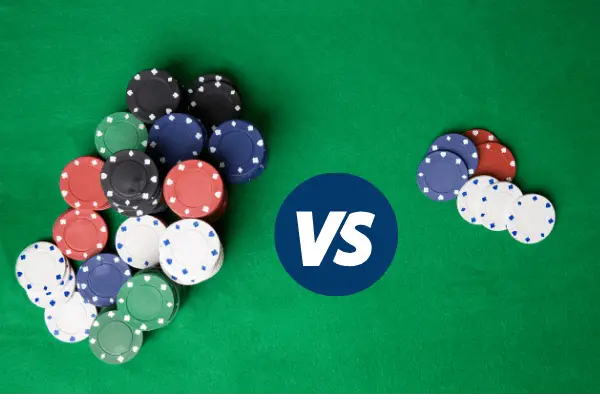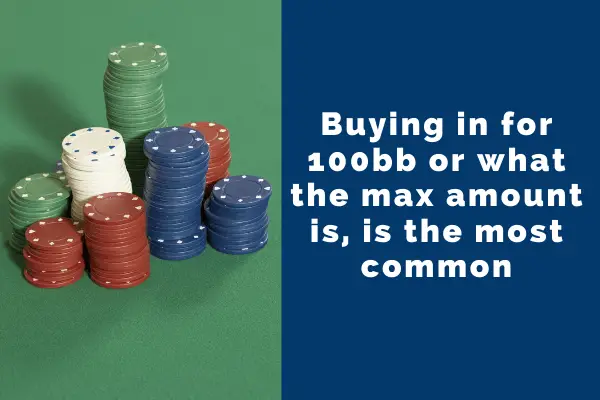When people sit down at a poker table, they buy in different amounts of chips. If you are new to poker, you are probably wondering why that is and what is the best stack size you should start with.
In a poker cash game, it is best if you start with the maximum allowed number of big blinds. On most tables, the maximum buy-in is 100 big blinds, but of course, there are some exceptions.
Some tables play much deeper, which means the maximum buy-in is also higher. It can be up to 250 big blinds or even more. Deep games are more common in live poker games, but there are also online poker games with that option, and they usually play with ante.
On the other hand, there are also tables with smaller maximum buy-ins. These are also called the shallow tables. Maximum buy-in at this type of table could be 20 or 40 big blinds. Of course, you can also play deep poker on these tables if there are a lot of rebuys, and people double up or triple up their stacks several times.

Let us explore different buy-in amount options and see when it’s good to buy in for that amount
Starting with a minimum stack
There are usually two types of players who buy-in for the minimum amount.
- Recreational players
- Professional short stackers
The first type is the recreational players. There are a lot of reasons why they buy-in for the minimum. They want to risk less money. They usually play for fun and don’t have any serious ambitions to grow their bankroll. Often they know they are the underdog in the game but still, want to play. So they prefer to buy in for less money, and because of that, they can afford more buy-ins if they happen to go all in and lose all of their chips.
Some players also like the thrill when they go all-in. They want to shove their stack as much as possible, and playing short stacked is much cheaper. This way, they can play more and last longer.
The second type of player who buy-in for the minimum is professional short stackers. Shotstackers employ a unique strategy and play a very tight and aggressive style. Their main goal is to end a hand pre-flop or on the flop and try to double up. If the hand is multiway, this benefits short stackers greatly. You are often all-in as a short stacker. And each time one of the players that are involved in the hand folds, it means a free increase in equity for you. Being all-in against one player is always better than against multiple unless you have the absolute nuts. In poker, you can’t just take the money off the table and continue to play (in poker slang, this is called ‘’going south”), so that is why once they double up, they usually leave the table and join a new one.
Short stacking is much more suitable for online play, where there are a lot of tables, and you can close one and join another one instantly.
In live games, this is much more complicated and takes much more time. If you are playing in a home game, where there is only one table running, you can’t change it and move to another. You can continue to play with the bigger stack, or you can leave. But if you do this every time you double up, you probably won’t get invited again. A lot of players don’t like this and consider it bad etiquette, although you are not breaking any rules by doing this.
Even in a casino, where there is more than one table running, it is not so easy to change tables. The whole process takes a lot longer than online. You have to sit out and manually put your chips in a rack. It takes a lot more than just a few clicks with a mouse online. After that, you have to find a new table with an open seat.
There are usually waiting lists for live tables in a casino, and a new table doesn’t open until there are a few players already waiting to play. If you do this every time you double up, it won’t be long before people start to avoid playing with you. So being a professional short stacker and buying in for the minimum is much harder in live games than it is online.
If you decide to start your game as a short stacker in live games anyway, you should strongly consider playing on even after you double up.
Starting with a full-stack

Buying in for the maximum is also known as full-stack poker, and it plays a lot differently when you are short stacking. Playing with more big blinds allows you to steal the blinds more often in poker, and it really allows you to exploit your opponents to the max, which will also skyrocket your win-rate. If you want to know how much exactly to raise when stealing the blinds, then check out this article.
This is of course true if you know what you are doing. If you are new to poker then playing a short stack strategy might be a correct play as it requires less thinking and many post-flop scenarios are solved by math already, you just need to learn them.
The most common choice for players is to sit down at a poker table with a full-stack. This is usually 100 big blinds, as explained above. People, in general, like to have more money on the table, so they can play more hands, see more flops, turns and rivers and don’t have to rebuy often.
All regulars and professional poker players also prefer to sit down with a maximum buy-in. They know they have the edge over weaker players and want to have more chips on the table than them. This way, when they go all in, they can cover a player who doesn’t match their skill level and take all their chips when they win.
Also, when bluffing, if you have more chips, you can put more pressure on the opponents and have more significant leverage on later streets. Therefore having a bigger stack makes your bluffs more likely to succeed.
Starting with various stacks
If you neither want to buy in for the maximum nor the minimum amount, you can buy in anything in between. Sometimes people buy in very strange amounts. It could be that they are superstitious, and this is their ‘’special’’ number. They feel that if they start with that amount, they will get lucky and win more, or there could be any other personal reason for that buy-in amount. As you will see, especially in live games, people are quite superstitious. This also reflects in their buy-in habits.
And lastly, there could also be a very logical explanation for why someone comes to the table with let’s say 73 big blinds. It could be that such player is shot taking at higher limits, and this is all the money he has, or he has lost everything except what big blinds he has in front of him.
Suggestions for you
If we sum up everything that was explained above, you can see that there is no one right answer for how many big blinds you should start with when you decide to play. It all depends on your specific situation, poker knowledge, bankroll, financial abilities, and how you think of the game.
In online games, you can automatically set your preferred amount. If you are starting your poker career and are not yet so comfortable at a poker table, it is better to play in lower games so you can also buy-in for less money. This way, the learning will not be so expensive. It goes the same if you are scared of losing too much money. Although in this case, it is probably better if you don’t play poker at all.
If you want to be a professional short stacker, your only option is to buy-in for the minimum. But for the more experienced players, who think they have the edge over other players, it is better to buy-in for the full amount. This way, when you win, you get to win the maximum you could have.



